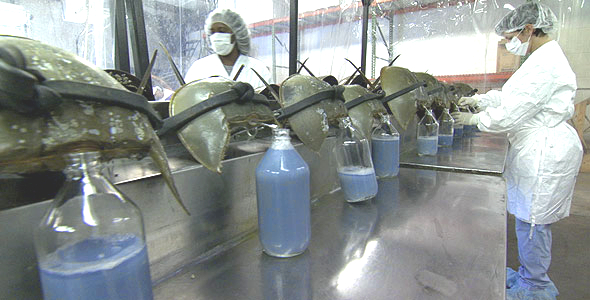Do you give much thought to horseshoe crabs? No, me neither. But it turns out that without them, we could be in a very precarious position. Horseshoe crabs – or to be more precise, their incredible, baby blue blood – are used to test for bacterial contamination, thus saving countless lives each year during medical procedures. The only trouble is, we have to catch a quarter of a million horseshoe crabs each year to do this, and then we have to drain their blood.
Horseshoe crab blood is unusual for two reasons. Firstly, it gets its incredible blue color from the copper used to carry oxygen around the crab’s body, in the same way the iron in hemoglobin makes our blood red. Secondly, horseshoe crab blood reacts to the presence of bacterial endotoxins, coagulating around the contamination and trapping it in a gel-like substance. The blood is so sensitive that it will react to a contaminant concentration of one part per trillion. The chemical component of the blood that causes this reaction, coagulan, is isolated from crab blood to be used in what is known as Limulus amebocyte lysate testing or LAL. LAL tests are performed on medical equipment, vaccines and other injectables: if they don’t cause a coagulation reaction, they’re clean.

In order to obtain horseshoe crab blood, around 250,000 live crabs are harvested along the east coast of the U.S. each year. They are transported to one of five companies, cleaned and then set up in racks for around 30 percent of their blood to be drawn. They are returned to the sea a few days after being caught and are returned quite a distance from the harvesting sites to ensure the same crabs aren’t bled repeatedly. It’s estimated that between 10 and 30 percent of the crabs die during or after the process. One study has also shown that the process is so taxing that female crabs travel less frequently to spawning grounds after being bled, thereby slowing down the rate of reproduction.
One quart of the crab blood extract used for LAL testing costs $15,000. The entire industry is worth $50 million annually. Until the use of of LAL tests was approved by the FDA in 1970, tests for bacterial infection were performed on rabbits. Not only were huge numbers of rabbits required for this process, but their fever reaction that indicates bacterial contamination takes around 48 hours to present. The LAL test takes around 45 minutes. Scientists are currently working on synthetic versions of the coagulant, with one product, PryoGene, already on the market. While this may be good for the horseshoe crabs in the short term, since the previous ways we’ve found to exploit them include using them as fertilizer and whelk bait, they may only be given a brief respite. Photos by PBS, and Chosovi via Wikimedia Commons. Info by B. Mitchell
